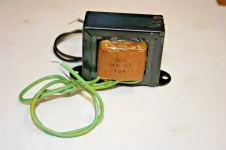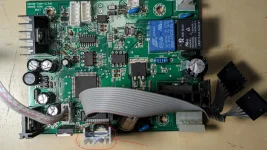You are probably running an actuator that is operating beyond its lifespan. That is why you had to pump it full of grease. I doubt you find find a grease fitting on a new heavy duty actuator. They are sealed units and what they have in them is supposed to last the lifetime of the unit. You are living the example of why they don't have grease fittings anymore: Cold weather.
Well. To counter that. Actually. One train of thought would be yeah. 5 years, swap it out. Except for the same dish my mom and dad had installed back in the 80's is still standing. And I use it today after some mild refurbishing. There is literally a box of actuators from Venture, Von Weise, Saginaw Gear, "Houston Tracker". Dad just wrapped a heat tape and sliped pipe insulation over it and ran an extension cord to keep it warm in the winter.
Funny. "End of life". No maintenance. Run 'er 'till she pukes. Installers back in the day loved it. It gives you crap. Call him. He shows and swaps the unit out. Resets your positions. And bills you.
If you didn't move that dish in the cold cold winter. No problems. Wait 'till spring. Or. Slap on a heat tape (even on a brand new replacement) and punch Satcom 4. Ba-da-bing!
Go ahead. I dare you. I challenge you. Take an aged but working fine actuator-du-jour. Throw it in the deep freezer and get it down to -10f. Give it some pixies.
You've probably never (or remember) trying to start a car in subzero temperatures. "ER-RRRR-RRR-RR-R....*Start*. IFyou're lucky. Not so lucky? After a few cranks...*click click click*
Charger time. And starting ether. Jesus! Automatic tranny's don't even have dipsticks anymore. And factory recommendations to never change the sauce in them. She pukes, swap 'er out.
Goodfellas...."eff you, pay me". Fred at your local independent service facility with beer in the fridge who happens to know and love your type of vehicle knows better.
Pull the pan. Dump "at least" some of the juice. And refill it. And 4 grand pending turns into a hundred-fifty bucks and 200k miles before trading in.
So. A drill. A zerk. A grease gun loaded with Lucas super low temp grease that looks like a nasty sinus infection discharge. Not exactly a bad thing. And it works. Tear down the motor. Clean and grease it. A pair of brushes from the auto parts or hardware store assortment. I rest my case.
Is a polar mount worn out when the pivots are sloppy and the bronze bushings are all hob-wobbly? Thirty bucks for pillow blocks. A few bucks for hardware. Center punch a few dimples. Drill a few holes. ratchet strap and c-clamp a few things in place. Mr. DeWalt and some sharp drills.
What would you think if I were to come out and condemn your Prodelin because the pivots were toast? Look at my quote for a new General Dynamics 12 footer. Nah. I don't think so.
Oh yeah. This is all grain of salt and backbone. Please don't turn into a shrinking violet.
I'm a living example of my economy is not disposable. American Ingenuity. Dislike for planned obsolescence. Drinking a cold beer under a shade tree from a recycled Hyundai and Kia.
One stinkin' hole. A grease fitting. Some pumps of goo. And Venture waits another day.
The reason is cheap. Vbox type Positioners are made from the cheapest materials known to man. Disassemble one sometime and you will see...
I never fully understood the ASC1 either. The stock transformer weighs something like 6-8 pounds. WHY? I have been running the small power supply's shown in post 4 of this thread for years without a failure The cost of one of those supplies was about 20 bucks or less when I bought them. They do a fantastic job of providing the needed DC voltage and watts to power satellite actuators. A satellite dish positioner is all about start-up. It only has milliseconds to move or you get a failure. Twenty something volts and an amp or two for current in cold weather probably doesn't cut it for some folks --even when using a mesh dish that is not very heavy.
The Vbox I can 100% agree on. It's open source and readily available for cheap to nothing to design and program. They work. The code is locked in the MCU by whomever decides to clone them.
Could they be made better? Certainly. Could they have a nice display like the ASC-1? Probably.
The ASC-1? It's a love/hate for me. All I want to do is repair a few. Reverse engineering the circuitry took a bit for the sections that show faults. And the whole design is "eyes only". I will need Brian's assistance after getting the circuitry aced. One, maybe two need microcontrollers. Not so hard to do with the right equipment and skill.
It's a Vbox in essense. With some really cool bells and whistles.
The motor power side is rectified xformer voltage. No regulation to speak of and prone to voltage/current sag. Something that a SMPS would handle most awesome. Plus just sitting in the case it sucks juice and makes heat. Again. something that SMPS supplies do very well in management of idle current.
And in agreement of the millisecond lag dish movement error generation. Try it when your motor grunts trying to get that negative-twenty molasses squishing.
Instead of drooping voltage and current running through X feet of cable. An smps senses it and compensates. Everyone needs a little boost once in awhile.
Vbox. Cheap. They work. No big sting if one takes a crap.
Make your own from a PIC mcu. Bare PC boards are out there.
Adruino. Now. That catches my interest. The diseqc library is freely available. Projects abound. Some are pretty cool.
The Research Concepts commercial dish movers. 1 axis, 2 axis. Ebay has quite a few nice ones for not too bad of a price.
It was mentioned. Reading from the FTA guys who use them. Pretty robust. Although you have to manually punch up a memory store to move your dish.
But they do have pc software and a RS422 interface. Bing!
Once i get the interest of the right Arduino guy I'll get very involved. Diseqc works on a data string. ASC-1, Vbox "listens" for the command to move to a memory location.
The Arduino motor control projects do the same thing.
It's all there for the Arduino. Instead of waiting for a go-to command and actuating relays and counting encoder pulses.
Let the Arduino receive the command. And relay it transcoded to a RS422 string that a RC mover understands. The data packets of diseqc are very similar to RC controller protocols. But different.
A display on the Arduino showing a command was sent from the receiver to move to SES-1, etc. And the RC mover doing it. No more dead Vbox. No more hoping that your ASC-1 wont die of sudden death.
Arduino guys please speak up!


